Content is from Kirkbride et al. 2006Kirkbride et al. 2006:
Kirkbride JH, Jr, Gunn CR, and Dallwitz MJ. 2006. Family guide for fruits and seeds, vers. 1.0. Accessed September 2020-January 2022. URL: https://nt.ars-grin.gov/seedsfruits/keys/frsdfam/index.cfm ., without modification.
Updates are forthcoming.
Fruits: Pistil(s) simple, or compound; 1; 1-pistillate; with carpels united. Fruit pericarpium; simple; camara (Hermandradenia), or coccum (Connarus Spjut only 3 families: Connaraceae, Myristicaceae, Proteaceae), or folliclefollicle:
a dry to (rarely) fleshy fruit derived from a single carpel that opens along a single longitudinal suture, derived from a single, superior, simple ovary; the seeds may be arillate or with a fleshy testa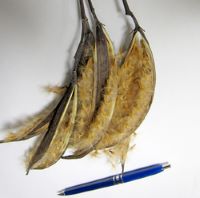 ; without persistent central column; not within accessory organ(s); 1-seeded, or more than 1 but less than 10-seeded; 1(–2)-seeded; with 1–5(–8)-carpellate (rarely 3 or 7); with carpels united; with carpels remaining united at maturity; without sterilesterile:
; without persistent central column; not within accessory organ(s); 1-seeded, or more than 1 but less than 10-seeded; 1(–2)-seeded; with 1–5(–8)-carpellate (rarely 3 or 7); with carpels united; with carpels remaining united at maturity; without sterilesterile:
lacking male and/or female reproductive parts; also, not producing fruit or seed
 carpels; apexapex:
carpels; apexapex:
the point farthest from the point of attachment, or the "tip" of an organ not beaked; wall crustaceouscrustaceous:
not beaked; wall crustaceouscrustaceous:
texture—thin, dry, indurate, and brittle
; dehiscentdehiscent:
(v. dehisce) splitting open at maturity to release contents (of a fruit) , or indehiscentindehiscent:
, or indehiscentindehiscent:
not opening on its own, as in a fruit
 (usually indehiscentindehiscent:
(usually indehiscentindehiscent:
not opening on its own, as in a fruit
 for Jollydora & Hermandradenia). Dehiscentdehiscent:
for Jollydora & Hermandradenia). Dehiscentdehiscent:
(v. dehisce) splitting open at maturity to release contents (of a fruit) unit seed(s). Dehiscentdehiscent:
unit seed(s). Dehiscentdehiscent:
(v. dehisce) splitting open at maturity to release contents (of a fruit) regularly; passively; linearly; by ventralventral:
regularly; passively; linearly; by ventralventral:
adaxial; of the side of an organ facing the axis (compare dorsal)
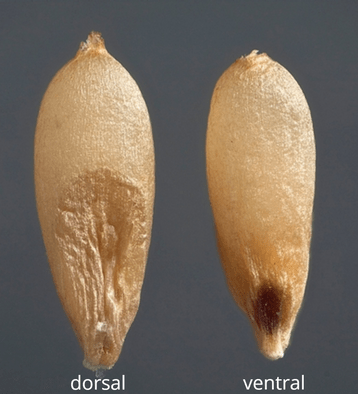 sutures (& occasionally along dorsaldorsal:
sutures (& occasionally along dorsaldorsal:
abaxial; the back of an organ; the side away from the axis (compare ventral)
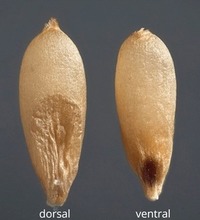 suture), or circumscissilecircumscissile:
suture), or circumscissilecircumscissile:
(~pyxis); type of capsular dehiscence, opens by a lid (splitting transversely)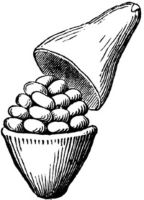 slit (at base); and shedding seeds; without replumreplum:
slit (at base); and shedding seeds; without replumreplum:
the rim, formed by the persistent placentas, and connected by a false septum in Brassicaceae fruits. The fruit valves are attached to this rim and separate from it in dehiscent fruits.
. Epicarpepicarp:
outer layer of fruit wall or pericarp, if divided into layers; note here used synonymously with exocarp orange, or red; durable; sub-sub-:
orange, or red; durable; sub-sub-:
a prefix meaning slightly, somewhat, or nearly (used with a descriptive term), or below (used with an anatomical term)
glabrousglabrous:
without hairs
, or not glabrousglabrous:
without hairs
(with hairs); hairs not glandularglandular:
surface relief—covered with small, raised secretory glands, regular or irregularly shaped, translucent or opaque, and maybe distinctly colored ; without armature; not smooth; glandularglandular:
; without armature; not smooth; glandularglandular:
surface relief—covered with small, raised secretory glands, regular or irregularly shaped, translucent or opaque, and maybe distinctly colored (dotted), or tuberculatetuberculate:
(dotted), or tuberculatetuberculate:
surface relief—bearing small, warty, swelling, rounded, or variously shaped projections ; without wing(s); without apicalapical:
; without wing(s); without apicalapical:
at or pertaining to the end of the seed or fruit distal from its point of attachment (i.e., base)
respiratory hole. Endocarpendocarp:
the inner layer of the pericarp, if divided into layers present; separating spontaneously from exocarpexocarp:
present; separating spontaneously from exocarpexocarp:
outer layer of fruit wall or pericarp, if divided into layers; note here used synonymously with epicarp , or not separating from exocarpexocarp:
, or not separating from exocarpexocarp:
outer layer of fruit wall or pericarp, if divided into layers; note here used synonymously with epicarp ; thin; not splitting into 1-seeded pyrenes; smooth; without wing; without operculumoperculum:
; thin; not splitting into 1-seeded pyrenes; smooth; without wing; without operculumoperculum:
a dehiscent cap (or lid) of a seed or fruit that opens during germination or dehiscence ; without secretory cavities; without mechanism for seedling escape; without longitudinallongitudinal:
; without secretory cavities; without mechanism for seedling escape; without longitudinallongitudinal:
of or relating to length or the lengthwise dimension
ridges. Funiculusfuniculus:
(alt. funicle) stalk connecting the ovule (later seed) to the ovary (later fruit) placenta short; short without seed bearing hookswith hooks:
short; short without seed bearing hookswith hooks:
bristles or spines with curved or backwards pointing tips, or with secondary bristles along their length (retinacula); not persisting in fruit after seed shed.
(retinacula); not persisting in fruit after seed shed.
Seeds: Arilaril:
(broad sense) appendicular structure that wholly or partly envelops a seed and is produced from or a modification of the funicle, raphe, or outer integument; usually fleshy or pulpy, sometimes spongy or tufted-capillate, often brightly colored mostly present, or absent; a true arilaril:
mostly present, or absent; a true arilaril:
(broad sense) appendicular structure that wholly or partly envelops a seed and is produced from or a modification of the funicle, raphe, or outer integument; usually fleshy or pulpy, sometimes spongy or tufted-capillate, often brightly colored ; red, or yellow; well developed; adnate to testatesta:
; red, or yellow; well developed; adnate to testatesta:
seed coat
 ; fleshy; of funicularfuniculus:
; fleshy; of funicularfuniculus:
(alt. funicle) stalk connecting the ovule (later seed) to the ovary (later fruit) placenta origin; basalbasal:
origin; basalbasal:
at or pertaining to the point of attachment; (of embryo) embryo occupies one end of the seed
; does not aid in seed explusion from fruit; fleshy; cupshaped, or cushionlike; unlobed. Seed larger than minute; 25 to less than 50 mm long; up to 40 mm long; sub ovateovate:
2D shape—egg-shaped in outline, widest point is towards one end of the organ, the other end tapers gradually, attachment at or near the broad end (compare obovate, ovoid) , or ellipsoidellipsoid:
, or ellipsoidellipsoid:
3D shape—elliptic
; not bowl shaped; not nutlike; without winglike beakbeak:
a usually firm, terminal appendage, sometimes tapered ; without caudatecaudate:
; without caudatecaudate:
tapering to a long, tail-like appendage appendage(s); at maturity with food reserves, or without apparent food reserves (thinner endosperms with thicker cotyledons); with endosperm; without canavanine. Sarcotestasarcotesta:
appendage(s); at maturity with food reserves, or without apparent food reserves (thinner endosperms with thicker cotyledons); with endosperm; without canavanine. Sarcotestasarcotesta:
pulpy or fleshy outer layer of the seed coat, simulates aril absent, or present (Vismianthus, Hermandradenia); fleshy (Hemandradenia). Testatesta:
absent, or present (Vismianthus, Hermandradenia); fleshy (Hemandradenia). Testatesta:
seed coat
 present; with fleshy or leatheryleathery:
present; with fleshy or leatheryleathery:
texture—moderately thick, tough, and very pliable
layer over hard layer, or without fleshy or leatheryleathery:
texture—moderately thick, tough, and very pliable
layer over hard layer; shinyshiny:
uniformly reflecting a high proportion of incident light at all angles ; surface smooth; without crease or line separating cotyledons from hypocotyl-radicle; without notch along margin where cotyledons from hypocotyl-radicle tip approach each other; without glands; without bristles; glabrousglabrous:
; surface smooth; without crease or line separating cotyledons from hypocotyl-radicle; without notch along margin where cotyledons from hypocotyl-radicle tip approach each other; without glands; without bristles; glabrousglabrous:
without hairs
; without wings; without collar; without operculumoperculum:
a dehiscent cap (or lid) of a seed or fruit that opens during germination or dehiscence ; colored; monochrome, or bichrome; black, or red, or yellow; fleshy, or thick; not becoming mucilaginousmucilaginous:
; colored; monochrome, or bichrome; black, or red, or yellow; fleshy, or thick; not becoming mucilaginousmucilaginous:
resembling mucilage; moist and sticky
when wetted; surrounding embryo. Endosperm copious to scant; hard, or fleshy; smooth; with oils (occasionally); without fatty acid containing cyclopropene; without apicalapical:
at or pertaining to the end of the seed or fruit distal from its point of attachment (i.e., base)
lobes; without chlorophyll; without isodiametric faceted surface; without odor. Embryo differentiated from food reserve; well developed; 1 per seed; completely filling testatesta:
seed coat
 (no food reserve), or partially filling testatesta:
(no food reserve), or partially filling testatesta:
seed coat
 (with food reserve), or nearly filling testatesta:
(with food reserve), or nearly filling testatesta:
seed coat
 (trace or scanty food reserve); 0.4–0.9 times the length of food reserve; at one end of seed not extending into a depression or cup; foliatefoliate:
(trace or scanty food reserve); 0.4–0.9 times the length of food reserve; at one end of seed not extending into a depression or cup; foliatefoliate:
appearing leaf-like
; with spatulatespatulate:
2D shape—like a spatula; rounded at the apex, with base long and tapered; (of embryo) embryo is straight and axile and centric with the cotyledons expanded to form the shape of a spatula or spoon; (of cotyledons) cotyledons expanded and wider than the stalk but not invested into the stalk cotyledons, or investinginvesting:
cotyledons, or investinginvesting:
(of embryo) embryo is nearly or completely filling seed coat, straight, and axile and centric with spatulate cotyledons and covering the stalk for at least half its length; (of cotyledons) cotyledons spatulate and covering the stalk for at least half its length
cotyledons (occasionally); straight; parallel to seed length; with cotyledons abruptly connected to hypocotyl-radicle; without coleorhiza; without simmondsin; without stomata; not green; with 2 or more cotyledons. Cotyledons 2; well developed; not divaricate; 0.7–9 times length of embryo; somewhat to significantly wider than hypocotyl-radicle; 2–7.5 times wider than hypocotyl-radicle; not concealing hypocotyl-radicle, or partially concealing hypocotyl-radicle; foliaceous; flat (or plano-convexplano-convex:
2D or 3D shape—flat on one side, convex on the other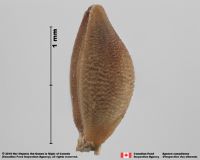 ); smooth, or ruminateruminate:
); smooth, or ruminateruminate:
testa or seed coat folded into the endosperm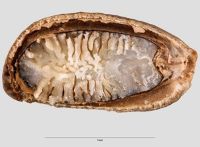 ; with apicesapex:
; with apicesapex:
the point farthest from the point of attachment, or the "tip" of an organ entire; with margins adhering; basally entire; equal in size; not punctatepunctate:
entire; with margins adhering; basally entire; equal in size; not punctatepunctate:
surface relief—dotted with pits or with translucent, sunken glands or with colored dots, similar to pitted dotted. Hypocotyl-radicle moderately developed; straight; not thickened.
dotted. Hypocotyl-radicle moderately developed; straight; not thickened.
Literature specific to this family: Breteler, F.W., ed. 1989. The Connaraceae: A taxonomic study with emphasis on Africa. Agric. Univ. Wageningen Pap. 89(6):1–403.
General references: Cronquist, A. 1981. An integrated system of classification of flowering plants, 1,262 p. Columbia University Press, New York, Engler, A. 1900–1953. Das Pflanzenreich, nos. 1–107. Facsimile edition. Engelmann-Cramer, Weinheim, Engler, A. & K. Prantl. 1924 and onward. Die Natürlichen Pflanzenfamilimien. W. Engelman, Leipzig, Gaertner, J. 1788–1805. De fructibus et seminibus plantarum. The Author, Stuttgart, Goldberg, A. 1986 (dicots) & 1989 (monocots). Classification, evolution, and phylogeny of the familes of Dicotyledons. Smithsonian Contr. Bot. 58 for dicots (314 pp.) & 71 for monocots (74 pp.). [Goldberg's illustrations are reproduced from older publications and these should be consulted], Gunn, C.R., J.H. Wiersema, C.A. Ritchie, & J.H. Kirkbride, Jr. 1992 & amendments. Families and genera of Spermatophytes recognized by the Agricultural Research Service. Techn. Bull. U.S.D.A. 1796:1–500, Mabberley, D.J. 1987. The plant-book, 706 p. Cambridge University Press, Cambridge, and Spjut, R.W. 1994. A systematic treatment of fruit types. Mem. New York Bot. Gard. 70:1–182.